Displaying items by tag: INNVENTIA
World first for Swedish environmental technology on a commercial scale
On 12 March, the North American pulp and paper company Domtar announced that it had started the operation of a facility for separating lignin from the process at its pulp mill in Plymouth, North Carolina. The facility is the first of its kind in the world on a commercial scale, based on the LignoBoost technology developed by Swedish research company Innventia and researchers at Chalmers University of Technology.
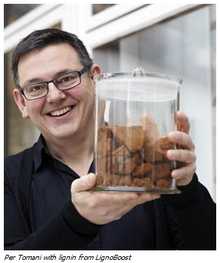 The successful installation of the LignoBoost facility represents the culmination of a research and technology project that Domtar began in 2010. BioChoice lignin is Domtar’s name for the product, and production in Plymouth – capacity around 75 tonnes per day – began in February this year. The lignin is intended to be used for a wide range of industrial applications, for example as a bio-based alternative to oil and other fossil fuels, or as raw material for other materials.
The successful installation of the LignoBoost facility represents the culmination of a research and technology project that Domtar began in 2010. BioChoice lignin is Domtar’s name for the product, and production in Plymouth – capacity around 75 tonnes per day – began in February this year. The lignin is intended to be used for a wide range of industrial applications, for example as a bio-based alternative to oil and other fossil fuels, or as raw material for other materials.
LignoBoost is a unique and effective process for extracting high-quality lignin from kraft pulp mills, and has generated a great deal of interest – both in Sweden and internationally. The technology has been developed since the late 1990s by Innventia in Stockholm, in association with Chalmers University of Technology, within the framework of three research programmes. In 2008, Innventia sold the LignoBoost concept to the technology company Metso, which is now delivering the first facility to Domtar.
“It’s extremely gratifying to see the technology being installed on a full scale,” says Innventia’s Per Tomani, one of the people behind LignoBoost. “Having worked on this right from the beginning, it’s a very special day when production goes live. Lots of people have been involved in the various R&D activities along the way, and I’m sure they all feel the same way too.”
The technology is being continuously improved. Metso and Innventia have been working together since 2008 to refine the technology and to develop new lignin applications in partnership with potential customers. Lignin is one of the main focus areas for Innventia’s research and development, and the work is being carried out in association with customers within the industry.
“It would be fantastic if this were to represent a reversal of the trend,” continues Per. “It creates opportunities for developing kraft pulp mills into modern biorefineries that can supply large volumes of products in addition to the traditional fibre products and by-products – primarily tall oil and electricity.
Innventia researcher is awarded SEK 500,000 for carbon fibre research
Innventia’s Hannah Schweinebarth has been awarded this year’s Skills Prize by the Gunnar Sundblad Research Foundation. The prize of SEK 500,000 will be used to develop new knowledge on the production of carbon fibre from the wood raw material lignin.
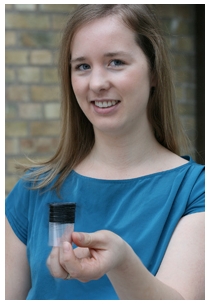 Hannah is a young employee at Innventia’s Biorefinery Processes and Products group. There, she carries out research within the focus area Lignin & Carbon, which covers the entire lignin production chain from black liquor to end products, such as lightweight carbon fibre materials.
Hannah is a young employee at Innventia’s Biorefinery Processes and Products group. There, she carries out research within the focus area Lignin & Carbon, which covers the entire lignin production chain from black liquor to end products, such as lightweight carbon fibre materials.
Carbon fibre is strong and light, with many applications, especially in the automotive industry. Today, demand is mainly limited by the high cost, with the petroleum-based raw materials and fibre spinning accounting for around 50 percent of the cost. Lignin, a substance that is found in wood but removed during kraft pulp production, has great potential for use as a raw material for manufacturing carbon fibre. Innventia has extensive experience in the production and characterisation of lignin from black liquor. Innventia worked with Chalmers University of Technology to develop the LignoBoost process (now owned by Metso), making it possible to extract a very pure lignin that could be used as a raw material for carbon fibre. The first industrial LignoBoost plant is now starting up at Domtar’s pulp mill in Plymouth, USA.
Thanks to the Skills Prize, Hannah will be spending six months at the Oak Ridge National Laboratory (ORNL) in Tennessee, USA. ORNL is one of the world’s leading “green energy” research centres, and is currently building a pilot plant which will produce about 25 tonnes of carbon fibre from lignin each year. This will enable Hannah to learn more about the properties of lignin and how they affect the properties of carbon fibre. The University of Tennessee will also be involved.
“It’s great fun!” says Hannah. “The prize represents an excellent opportunity for development, both professionally and personally. I get to come to a new country and an environment that provides completely new aspects for what I’m doing. I think that lignin offers tremendous potential, and it’s fun to be involved.”
“Carbon fibre from lignin is a new and expanding area for us, and one where we are now investing in more advanced equipment for further development,” says Peter Axegård, Director of Innventia’s Biorefining business area. “Knowledge building is also very important in terms of acquiring the necessary skills. We are therefore looking forward to this collaboration with ORNL, which will benefit Sweden and Innventia in many ways.”
About the prize
The Gunnar Sundblad Research Foundation’s Skills Prize has been awarded annually since 2007. The prize aims to promote the development of the Swedish pulp and paper industry towards new and improved products and services that can meet today’s increasingly tough competition. The prize enables a researcher from the Swedish research and innovation system to work at a foreign research environment in order to develop, make contacts and bring home new knowledge. The Gunnar Sundblad Research Foundation Board is appointed by the Swedish Forest Industries Federation Board. Find out more at www.skogsindustrierna.org.
Global consumers demand smarter packaging
Global consumers are guided by product packaging in their buying behaviour, not least in India. We reject products in plastic packaging and feel guilty when we throw away plastic water bottles. We worry about the amount of packaging consumed by society, and when shopping online we might consider having goods delivered in simple standard packaging instead of the original packaging if it makes them cheaper. These are the results of an international study by Innventia, Packaging 2020, carried out in association with Kairos Future.
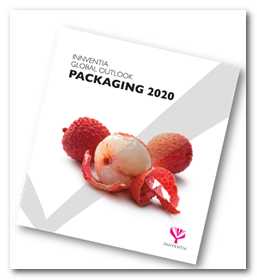 The report describes seven global forces and their impact on the packaging industry and the packaging of the future. The conclusions are based on a survey carried out among consumers in the US, India and Sweden. A clear majority of the 1,500 interviewees see major problems with society’s consumption of packaging.
The report describes seven global forces and their impact on the packaging industry and the packaging of the future. The conclusions are based on a survey carried out among consumers in the US, India and Sweden. A clear majority of the 1,500 interviewees see major problems with society’s consumption of packaging.
There are particular concerns about the environmental impact of packaging in India, where a full 60 percent are prepared to go so far as to avoid purchasing a specific product if the packaging is seen to be environmentally unfriendly. The corresponding figure in Sweden is 20 percent. Plastic packaging is deemed to be the biggest environmental villain among Americans and Indians, while it is mainly aluminium packaging that Swedes shy away from. There are demands for tougher quality controls and stricter environmental legislation, and a clear majority of consumers in all three countries would like to see somewhat stricter or much stricter environmental legislation.
Global consumers – particularly those in Sweden – are keen to see more innovative packaging. For example, three out of five (63 percent) would like to be able to scan goods to find out more about their origin and delivery, as well as detailed information about the content.
“A growing global middle class, an aging population, limited access to raw materials and intensified urbanisation are a few of the megatrends posing challenges for the product and packaging industry,” says Fredrik Rosén, Manager of the Market and Consumer Insight group at Innventia.
“We’re seeing purchasing decisions being guided by the packaging material itself, not just the appearance of the packaging. We’re also seeing a clear demand and a great need for smarter packaging. In the future, stricter demands will be placed on packaging materials that come into contact with foodstuffs. The growth in online shopping will bring both challenges and opportunities for the packaging industry. For example, will the brown cardboard boxes that products are usually shipped in today still be as brown and boring in the future, or will they become an important part of branding? When it comes to the packaging value chain, as the quest for high quality raw materials intensifies, recycling players will occupy a significantly stronger position. And it’s not unlikely that we’ll see structural collaboration, whereby recyclers become involved in other parts of the value chain.”
The report can be ordered from www.innventia.com/packaging2020.
For more information and to request an electronic copy of the report, please contact Fredrik Rosén, Manager of the Market and Consumer Insight group at Innventia, This email address is being protected from spambots. You need JavaScript enabled to view it., tel. +46 (0)8 67 67 334.
The report in figures:
- 56 percent of consumers in India say that recycling is extremely important to them, compared to 32 percent in Sweden and 37 percent in the US.
- When shopping online, 94 percent of Swedes would consider paying less for goods delivered in simple standard packaging instead of the original packaging.
- 20 percent of Swedish consumers worry very often about packaging containing harmful substances. The corresponding figure in India is 43 percent.
- In India, 50 percent think that much stricter environmental legislation is needed. In Sweden, 17 percent take the same view, while 43 percent think legislation should be somewhat stricter.
- 60 percent of consumers in India avoid purchasing goods if the packaging is perceived to be environmentally unfriendly. In Sweden, the figure is 20 percent.
- 8 percent of Swedes worry that food may have thawed out on its way to the shop. The corresponding figure in India is 77 percent.
- 65 percent of Swedish consumers think that plastic is the least environmentally friendly material, compared with 47 percent for aluminium and 4 percent for paper (multiple answers were possible). In India, 30 percent think that paper is the least environmentally friendly material.
- 80 percent of Swedes think that requiring consumers to wear plastic gloves when handling fruit in a food shop is a bad idea, but 65 percent of consumers in India think this is a very good idea.
- 29 percent of Americans buy food online at least once a month. The corresponding figures are 35 percent in India and 5 percent in Sweden.
- 81 percent of Americans over the age of 55 say that the most irritating thing about packaging is difficulties opening it.
- 63 percent of Swedes say that they would be interested or extremely interested in being able to scan goods to find out more about their origin and delivery, and/or detailed information about the content.
- 44 percent of Swedish consumers have chosen one product over another in the last month, simply because it has been produced locally. The corresponding figure in the US is 32 percent.
- 87 percent of Swedes taste milk before discarding it once it has passed its best before date.
About the survey
A quantitative survey was carried out in order to measure the attitudes, feelings and behaviours of the public in relation to the issues dealt with in the report. The survey was carried out in October 2012 using access panels with respondents in India, Sweden and the US. There were 500 respondents in each country, and the results were weighted to increase representativeness in terms of gender and age. Since the survey was carried out using internet panels, the Indian responses do not correspond to the population as a whole but rather to the Indian middle class, which was the intention of the survey.
INNVENTIA AB is a world leader in research and development relating to pulp, paper, graphic media, packaging and biorefining. Our unique ability to translate research into innovative products and processes generates enhanced value for our industry partners. We call our approach boosting business with science. The Innventia Group is situated in Stockholm, Bäckhammar, Trondheim and London. www.innventia.com
KAIROS FUTURE Kairos Future is an international consulting and research company that helps businesses to understand and shape their futures. For more information, visit www.kairosfuture.com.
One step closer to wood-based carbon fibres
On 18 December, Ylva Nordström defended her licentiate thesis “Development of softwood kraft lignin based carbon fibers” at Luleå Technical University. The work was carried out within the LigniCarb project at Innventia and demonstrates promising research findings with carbon fibres from softwood lignin, a raw material which has been considered impossible to process into precursor fibres.
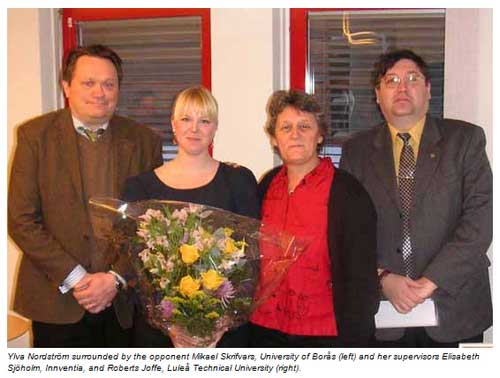
Polymer composites designed for high-performance applications are mostly based on carbon fibre reinforcement, produced from fossil originating raw materials such as poly(acrylonitrile) and pitch (petroleum- or coal-based). As of today, lignin has proved to be one of the most promising alternatives. Lignin is a substance that is found in wood but is removed during kraft pulp production. Thanks to LignoBoost technology*, the pulp mill can extract extremely pure lignin which could be used and thus increasing the access to a raw material for carbon fibre. Previous research has mainly focused on the use of hardwood lignin which is easier to meltspin. However, the presented work by Ylva Nordström states that precursor fibres also can be produced from kraft lignin from softwood, which is the most common industrial wood raw material in the northern hemisphere, such as the Nordic region and North America.
The aim of this work was to find a way for melt spinning of softwood kraft lignin which was managed by adding small amounts of low-molecular lignin. Both unfractionated hardwood and softwood lignin were used with addition of their fractionated counterparts acting as softening agents. As previously reported in Ida Norberg’s PhD thesis, the stabilisation step in the process was also further developed as a first step towards a process optimised for softwood kraft lignin based carbon fibres. In Ylva Nordström’s work, mechanical characterisation of the final carbon fibres was carried out. The experimental results and predictions showed a good fit, although the strength of the produced fibres is still significantly lower than that of commercially available carbon fibres
“This thesis reports the first mechanical characterisation of softwood kraft lignin based CFs. This will hopefully enable further process optimisation”, says Ylva Nordström.
Ylva’s licentiate work was carried out within the framework of the LigniCarb/LigniCarb Add research project, with the aim of examining and demonstrating the possibilities of making carbon fibre from kraft lignin. The work constitutes a part of Innventia’s new field of research on production processes for lignin-based carbon fibres.
“There’s a lot to be gained from better equipment. Thanks to the recent promising findings in this field, investment in larger scale, more advanced equipment is now being planned,” adds Elisabeth Sjöholm, who was Ylva’s supervisor at Innventia and the project manager for LigniCarb.
*LignoBoost has been developed in partnership between Innventia and Chalmers University of Technology. The process has been successfully demonstrated at Innventia’s demonstration facility in Bäckhammar. The LignoBoost process, including patent rights, has been owned by Metso since 2008.
Emittance values to improve the accuracy of thermographic measurements
Caroline Hyll presented her licentiate thesis “Infrared emittance of paper – method development, measurements and application” at Innventia. This work will enhance the use of thermography in the pulp and paper industry.
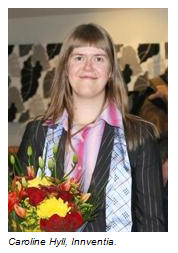 Thermography is a non-destructive technique which uses the emitted infrared radiation to determine the surface temperature distribution of an object. The technique is increasingly used in the pulp and paper industry. To convert the detected infrared radiation to temperature, the emittance of the material must be known. The emittance is a radiative material property which may vary with wavelength, temperature, observation angle, moisture content, material composition, material structure, and surface roughness. An as exact as possible emittance value for a given measurement situation is therefore crucial for the accuracy of thermographic measurements.
Thermography is a non-destructive technique which uses the emitted infrared radiation to determine the surface temperature distribution of an object. The technique is increasingly used in the pulp and paper industry. To convert the detected infrared radiation to temperature, the emittance of the material must be known. The emittance is a radiative material property which may vary with wavelength, temperature, observation angle, moisture content, material composition, material structure, and surface roughness. An as exact as possible emittance value for a given measurement situation is therefore crucial for the accuracy of thermographic measurements.
The emittance of paper has not been studied for many of the conditions that are encountered in a paper mill. This general lack of information may partly be explained by limitations of existing emittance measurement methods. No emittance measurement method that allows for variation of temperature, observation angle and moisture ratio exist. Additionally, the emittance of paper may not be predicted by current analytical models. The limitations of existing models stress the importance of measuring the emittance.
The aim of this thesis is to improve the accuracy of thermographic measurements in the pulp and paper industry by providing emittance values for different materials under different process conditions. These values can also be used in future modelling of infrared emission from paper at different stages in the papermaking process.
Based on a thorough literature study providing state of the art knowledge, a new angle-resolved goniometric emittance measurement method suitable for paper samples exposed to different temperatures and moisture ratios was developed. Followed by verification testing and error analysis of the system, a large number of angle-resolved emittance measurements were made on paper and board in conditions similar to those at different stages in the papermaking process. The method was applied, and the applicability of measured emittance values to quantitative thermographic measurements was demonstrated.
“I hope that my work will be of use in the pulp and paper industry. Companies that want to use this technique should be able to find values and references applicable to their processes in the thesis,” says Caroline Hyll.
“Caroline’s thorough experimental studies and method development help us a lot when we perform thermographic measurements both in the laboratory and in paper mills,” says Hannes Vomhoff who has been Caroline’s supervisor at Innventia.
Heat and pressure form new all-cellulose composite material
 On 30 November, Helena Halonen defended her doctoral thesis “Structural changes during cellulose composite processing”. Her work demonstrates two methods for creating a new composite material based only on cellulose fibres.
On 30 November, Helena Halonen defended her doctoral thesis “Structural changes during cellulose composite processing”. Her work demonstrates two methods for creating a new composite material based only on cellulose fibres.
In a composite material, the reinforcing agent and the matrix must adhere well at the interface; any effect can reduce the strengthening effect. Using components composed of the same material, as in all-cellulose composites, the adhesion at the interface is expected to be improved. In addition, this construction would improve the recyclability of the material.
In her thesis, Helena Halonen presents a production method that entails more advantages including low cost, simplicity and relatively predictability. The method involves the use of existing raw materials, i.e. pulps that are already available from the pulp mills. Biocomposites based on chemical pulp or dissolving pulp are processed via compression moulding, a commonly used technique found in nearly all industrial sectors. It would therefore be relatively easy to implement the method in an industrial installation.
Structural changes during processing have been studied as well as the relation between the organisation of cellulose fibrils in the fibre cell wall and the mechanical properties of the end material. A higher press temperature yielded increases in the fibril aggregation, higher stiffness and better water resistance. The experiments show that the optimum press temperature would be 170 °C in order to achieve fast drying without the material being broken down thermally, while still having excellent mechanical properties.
The thesis also describes a method for producing biocomposites based on bacterial cellulose fibril aggregates from Gluconacetobacter xylinus processed through a biosynthesis. The formation of cellulose fibrils was affected by the addition of hydroxyetylcellulose (HEC) which resulted in a biocomposite with remarkable mechanical properties including improved strength, modulus and toughness. The HEC coating improved the fibril dispersion and prevented fractures.
“Helena has demonstrated the importance of fundamental understanding of linking process induced modifications in the fibre cell wall structure to the final product properties,” says Assoc. Prof. Tommy Iversen who has been Helena's supervisor at Innventia.
“Helena’s doctoral work is an important contribution to the ‘renewable materials’ area and shows a great potential for wood as a raw material base,” says Catharina Ottestam, Director of business area Packaging Solutions at Innventia.
Pre-treatment of MFC controls properties and energy consumption
On 17 October, Mikael Ankerfors obtained his licentiate degree with his thesis “Microfibrillated cellulose: Energy-efficient preparation techniques and key properties”, which summarizes the effects of research within this field at Innventia.
 The forest industry is looking for new business opportunities and products, and nanocellulose is an exciting possibility. Nanocellulose, also known as microfibrillated cellulose (MFC), is a potential bulk product with possible uses including as a strengthening component in other materials, such as paper and bioplastics. It could also be used in a diverse range of applications such as barrier materials for packaging, food additives, cosmetics, pharmaceuticals and electronics. At Innventia, research has focused mainly on the actual process – being able to produce nanocellulose in a way that is as energy-efficient as possible – and many advances have been made. Based on these research findings, a pilot facility was built in 2010 to produce nanocellulose in sufficient quantities for further development towards practical applications.
The forest industry is looking for new business opportunities and products, and nanocellulose is an exciting possibility. Nanocellulose, also known as microfibrillated cellulose (MFC), is a potential bulk product with possible uses including as a strengthening component in other materials, such as paper and bioplastics. It could also be used in a diverse range of applications such as barrier materials for packaging, food additives, cosmetics, pharmaceuticals and electronics. At Innventia, research has focused mainly on the actual process – being able to produce nanocellulose in a way that is as energy-efficient as possible – and many advances have been made. Based on these research findings, a pilot facility was built in 2010 to produce nanocellulose in sufficient quantities for further development towards practical applications.
Mikael Ankerfors’ thesis describes three alternative processes for producing MFC, in which pulp fibres are first pre-treated and then homogenized using a high-pressure homogenizer. In one process, fibre cell wall delamination was facilitated with a combined enzymatic and mechanical pre-treatment. In the two other processes, this was done by introducing anionically charged groups into the fibre walls. All three processes are industrially feasible and enable production with considerably lower energy consumption – 91-98 percent lower – than that presented in earlier studies. By optimizing this pre-treatment, the quality – such as a film’s mechanical and optical properties and oxygen barrier – can be improved. The materials produced have been characterized in various ways, and it has been demonstrated that the MFCs produced are approximately 5-30 nm wide and up to several microns long.
Nanocellulose is an important part of Innventia’s research into material processes. Mikael’s licentiate thesis now provides a summary of various research collaborations in recent years.
“This work is an effect of international cooperation within projects financed by the EU and VINNOVA, as well as work within Innventia’s industry-financed Cluster Research Programme,” he explains.
“A great deal is being done by many different players, and I am delighted to be able to present a thesis summarizing some of what we can currently achieve when it comes to MFC.” “We hope that MFC will become a commercial product,” says Torgny Persson, Director of Business Area Material Processes at Innventia. “For example, Stora Enso is now investing in a pre-commercial production facility in Imatra. The research carried out together with the pilot facility is absolutely crucial in order for companies to make further progress.”
Stockholm conference draws hundreds of paper physicists and paper chemists
 For the first time, the International Paper Physics Conference and the International Paper and Coating Chemistry Symposium were held at the same time, in the same location and with a coordinated programme. Paper Conferences 2012 in Stockholm was a resounding success, attracting more than 400 participants from 24 different countries, and exceeding all expectations of the organisers, Innventia and the Royal Institute of Technology. By the time the final speaker left the podium on Thursday afternoon, a total of 138 presentations, together with several poster presentations, had been given during four days of parallel sessions at Stockholm’s Clarion Hotel Sign.
For the first time, the International Paper Physics Conference and the International Paper and Coating Chemistry Symposium were held at the same time, in the same location and with a coordinated programme. Paper Conferences 2012 in Stockholm was a resounding success, attracting more than 400 participants from 24 different countries, and exceeding all expectations of the organisers, Innventia and the Royal Institute of Technology. By the time the final speaker left the podium on Thursday afternoon, a total of 138 presentations, together with several poster presentations, had been given during four days of parallel sessions at Stockholm’s Clarion Hotel Sign.
“A joint event has meant greater exposure,” explains Marco Lucisano, chairman of the organising committee. “We were able to attract more researchers than if we had held the conferences separately. It has also meant greater exposure for the participants, who have had access to more talks and other participants. We’re particularly pleased to note that nearly 40 percent of the participants were industry representatives. This shows that the content of the conferences is relevant in terms of meeting both current and future industrial challenges.”
Prizes were awarded for the best poster presentations at the conference dinner, held at Winterviken on 13 June. The paper physics award went to Paul-Philipp Post, Christian Berger, Klaus Villforth, Heinz-Joachim Shaffrath and Samuel Schabel for the poster ”Optical measurement of deformation of paper under tensile load”, while the paper chemistry award was presented to Florian Loyal, Melanie Gattermayer and Markus Biesalski, for the poster ”Mussel-inspired polymers for papermaking and functionalization”. Franz Schmied received the prestigious Best Presentation Award for his talk “A model approach to understand the fiber – fiber bond”, as voted for by participants at the International Paper Physics Conference 2011 in Graz.
Magnus Hall New Chairman of the Board
Magnus Hall, President and CEO of Holmen, has been elected as successor to Mats Norlander, Stora Enso, in the position of Chairman of the Innventia Board of Directors. At the General Meeting of Shareholders, Mikael Hannus, Stora Enso, was also elected as new member of the Board, replacing Sven Wird, Holmen.
“We are very pleased to welcome Magnus Hall and Mikael Hannus and look forward to their support for our business,” says Birgitta Sundblad, President of Innventia.
“The forest industry is currently experiencing a period of structural change, in which research and development will play a more important role than ever before. It is now we need to identify the products of the future. Being part of this process as Chairman of the Board of Innventia is an incredibly exciting challenge,” says Magnus Hall.
Birch provides renewable plastic raw material
Green modification of the natural polymer xylan improves a number of material properties according to new licentiate thesis by Johanna Persson.
One of the biggest driving forces behind biorefining is replacing today’s fossil-based products with alternatives made from renewable resources. Wood raw materials are both renewable and plentiful, but the biggest gains are made if the residual products from the kraft pulp mill that leach out during cooking can be used. These residual products include lignin and hemicellulose. Innventia has carried out successful research and development into processes within the field of lignin with many potential products such as carbon fibre, activated carbon and dispersants. Now, hemicellulose is also being introduced.
A significant proportion of hardwood – up to 30 percent – consists of the hemicellulose xylan. Xylan is a natural polymer that is leached out from the fibres but not destroyed during kraft cooking. Xylan could therefore be used as a raw material for manufacturing barrier films for food packaging or other polymer materials. However, there are a number of difficulties when using xylan: it is water soluble, it is not thermally formable, and it is not easy to make films from. Johanna Persson has taken on these challenges in her studies.
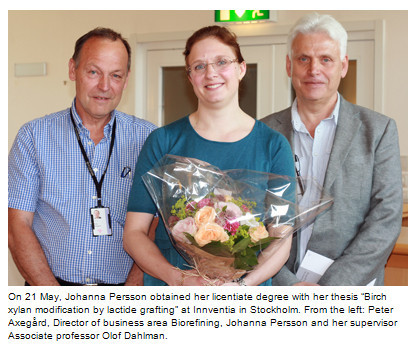
“I took the fact that we can already produce xylan from black liquor as my starting point,” she explains. “Using chemical modification – an organic synthesis – I then tried to influence the hydrophilic, thermal and film-forming properties.”
The modification involves grafting lactide, which is produced in plants, onto xylan, thereby creating branches – or side chains – of polylactide. The length of these chains determines the properties of the material.
“The difficulty comes in controlling the length of these chains,” continues Johanna. “An article I read led me to discover a catalyst (triazabicyclodecene) that has proven to be highly effective. We can now produce lactide-grafted xylan with a specific branch length, giving us a broad spectrum of different materials that can be processed thermally and are not soluble in water. We can also produce strong self-supporting films with a tensile strength of up to 48 MPa.”
“Our use of ‘green modification’ may result in many new applications from renewable resources such as xylan,” adds Olof Dahlman, who was Johanna’s supervisor at Innventia.
